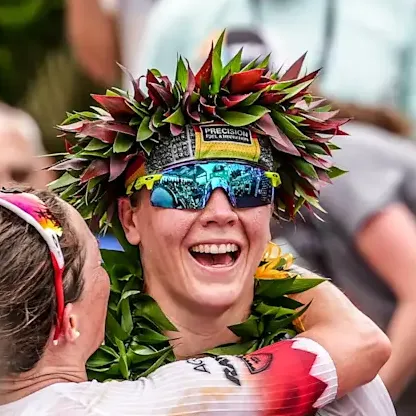
Solveig Løvseth
IRONMAN® World Championship
Solveig's headline numbers
Solveig's strategy
Fueling
Carbohydrate is the main fuel you burn when racing. Failing to fuel properly is a leading cause of underperformance in longer races.
Solveig hit ~132g of carbohydrate per hour en route to being crowned IRONMAN® World Champion in Hawaii. In what was only her third IRONMAN®-distance race, Solveig consumed ~145g/h on the bike leg and posted the fastest split of the day with a blistering time of 4:31:53 for the 180km. She hit her numbers by carrying PF 300 Flow Gel in two bottles, so that she didn’t need to slow down to pick anything up at aid stations.
For the run, Solveig placed five Flow Flasks containing PF 300 Flow Gel at the pro aid stations, where they were kept cool until she picked them up. Each flask delivered ~60g of carb, which ensured she was able to hit an impressive ~139g/h across the marathon. To handle such a high level of carb intake without difficulty, Solveig has been conducting gut training, with a particular focus on being able to consume carbs in hot and intense conditions to simulate the strain that she’d experience in the heat and humidity of Hawaii. This preparation paid off late in the race as she stayed strong when some of her fellow competitors began to fade.
Hydration
Taking on board an appropriate amount of fluid and sodium is essential to maintaining blood volume and supporting the cardiovascular effort needed to perform on race day.
Whilst the absolute amount of sodium and fluid consumed per hour is important, it’s critical to consider these in relation to each other. This is known as 'relative sodium concentration' and it’s expressed in milligrams per litre (mg/L). How much sodium you’re taking in per litre of fluid is more important than the absolute amount taken in per hour.
Sweat sodium concentration (mg/L) is largely genetically determined and remains relatively stable. Knowing how salty your sweat is enables you to replace a good proportion of your sweat losses, which can range from 200-2,000mg/L.
Whilst Solveig’s losses are on the moderate side, getting her hydration strategy right is still crucial when it’s hot and/or humid as her higher sweat rate in these conditions can result in significant net losses over the duration of a race.
Learn moreSolveig had spent the entire year preparing for the brutal conditions of Kona and she spent a lot of time undergoing heat training. She felt that spending time acclimatising to the heat was the biggest factor in being able to tolerate the sweltering conditions on race day.
The heat training also gave her a chance to get a handle on her fluid requirements in race simulation conditions and, based on her sweat rate testing, she aimed to drink ~1.2L/h to replace most of her sweat losses on the bike. On the run, she was aiming to drink in excess of 1.5L/h to limit the rate of dehydration across the hottest part of the day. The Norwegian superstar supplemented her fluid intake with sodium to closely match her own individual losses. She loses ~1,044mg of sodium per litre of sweat and she replaced a decent proportion of those losses as the relative sodium concentration of her intake across the race was ~844mg/L, which was largely achieved by using PH 1500.
Caffeine
Beyond the Three Levers of Performance (carb, sodium and fluid), caffeine is one of only a few substances that is proven to improve performance for most endurance athletes as it can help stave off mental and physical fatigue.
As a former short-course athlete, Solveig doesn't shy away from using caffeine in races. To keep things simple, she gets her caffeine on board by consuming two PF 30 Caffeine Gels at three different points in the race: pre-race, halfway through the bike leg and then one hour into the marathon. Taking her caffeine early on the run leg gave it enough time to be absorbed into her system and meant she could feel the full ergogenic effects of this final dose during the crucial final hour of the race.
How Solveig hit her numbers
Here's everything that Solveig ate and drank on the day...
Solveig's weapons of choice
Final thoughts
Solveig's full stats
Data Confidence?
There is good confidence in the accuracy of the data reported. An athlete feels that the numbers closely reflect what they consumed despite a couple of estimations which may carry some degree of error. The majority of what was consumed is recorded to a high level of specificity (most volumes are known through the use of bottles brands quantities flavours). The numbers are very plausible and align with previous data recordings (if an athlete has collected data previously).